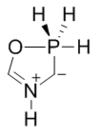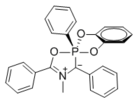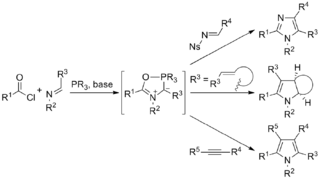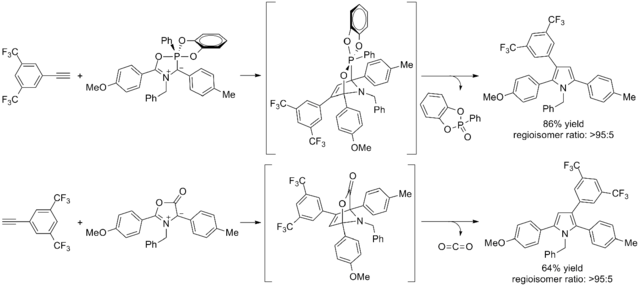Chemistry:Montréalone
 Montréalone parent compound
| |
| Identifiers | |
|---|---|
3D model (JSmol)
|
|
PubChem CID
|
|
CompTox Dashboard (EPA)
|
|
| |
| |
Except where otherwise noted, data are given for materials in their standard state (at 25 °C [77 °F], 100 kPa). | |
| Infobox references | |
Montréalone (synonyms: montrealone, phospha-münchnone) is a mesoionic heterocyclic chemical compound. It is named for the city of Montreal , Canada, which is the location of McGill University, where it was first discovered.[1]
Structure
The montréalone parent compound has been studied theoretically,[2] and is unlikely to exist as a stable species. Analogs bearing multiple substituents display stability suitable for synthesis, isolation, and characterization.[3] Substituted montréalones with a balance of stability and reactivity have been used as reaction intermediates in the synthesis of other heterocycles.
Theoretical and experimental analysis of stable montréalones reveals overlapping azomethine ylide and Wittig-type moieties within the unsaturated 5-membered organophosphorus ring system. Depending on the phosphorus substituents, ring-chain valence tautomerism allows montréalones to display variable degrees of equilibrium and structural blending with N-acyl amino phosphonium ylide forms. The cyclic 1,3-dipolar form is detectably or exclusively formed with phosphite and phosphonite-based analogs. Triphenylphosphine-based variants lack sufficient tendency for intramolecular cyclization, and exist as acyclic phosphonium ylides.[2][3][4][5]
Synthesis
Montréalones are related to Wittig reagents and can be generated in a similar fashion. Reaction of organophosphorus(III) compounds with N-acyliminium ions affords phosphonium salt intermediates which are deprotonated using non-nucleophilic bases (e.g. DBU, LiHMDS). N-Acyliminium ions are generated in situ from acid chlorides and imines such that the '1,3-dipole' itself is generated in a multi-component reaction. The most efficient phosphorus(III) precursor for dipole synthesis is 2-phenylbenzo[d][1,3,2]dioxaphosphole [PhP(catechyl)] owing to the balance of nucleophilicity and electrophilicity that it affords.[4]
Reactions
Montréalones participate in 1,3-dipolar cycloaddition reactions with dipolarophiles such as imines, alkenes, and alkynes to respectively afford imidazoles,[6] 2-pyrrolines,[7] and pyrroles.[3][8] The latter heterocyclic products were obtained by multi-component reactions involving in situ-generation of montréalones from imines, acid chlorides, and phosphonites prior to one-pot reactions with the dipolarophile. Moreover, conjugated poly(1,3-dipole) variants of montréalones have been generated and used in the synthesis of polyheterocycles related to polypyrroles.[9][10]
Cycloaddition reactions of asymmetric 1,3-dipoles and dipolarophiles can lead to isomeric product mixtures, particularly with münchnones and alkynes in the synthesis of pyrroles.[11][12][13] In contrast to related Diels-Alder reactions, rationalization of regioisomeric bias using conventional frontier molecular orbital (FMO) theory fails. The complementary use of montéalones and münchnones allows product mixtures to be avoided and highlights the need to consider transition-state geometrical changes (distortion) in the rationalization process.[14]
See also
References
- ↑ Reissig, Hans-Ulrich; Zimmer, Reinhold (2014-09-08). "Münchnones-New Facets after 50 Years" (in en). Angewandte Chemie International Edition 53 (37): 9708–9710. doi:10.1002/anie.201405092. PMID 25045012. https://onlinelibrary.wiley.com/doi/10.1002/anie.201405092.
- ↑ 2.0 2.1 Krenske, E. H.; Houk, K. N.; Arndtsen, B. A.; St. Cyr, D. J., Cyclic 1,3-Dipoles or Acyclic Phosphonium Ylides? Electronic Characterization of "Montréalones". J. Am. Chem. Soc. 2008, 130, 10052. (doi:10.1021/ja802646f)
- ↑ 3.0 3.1 3.2 St-Cyr, D. J.; Morin, M. S. T.; Belanger-Gariepy, F.; Arndtsen, B. A.; Krenske, E. H.; Houk, K. N., Phospha-Münchnones: Electronic Structures and 1,3-Dipolar Cycloadditions. J. Org. Chem. 2010, 75, 4261. (doi:10.1021/jo1008383)
- ↑ 4.0 4.1 St. Cyr, D. J.; Arndtsen, B. A., A New Use of Wittig-type Reagents as 1,3-Dipolar Cycloaddition Precursors and in Pyrrole Synthesis. J. Am. Chem. Soc. 2007, 129, 12366. (doi:10.1021/ja074330w)
- ↑ Reissig, H.-U.; Zimmer, R., Münchnones—New Facets after 50 Years. Angew. Chem. Int. Ed. 2014, 53, 9708. (doi:10.1002/anie.201405092)
- ↑ Aly, S.; Romashko, M.; Arndtsen, B. A., Multicomponent Synthesis of Substituted and Fused-Ring Imidazoles via Phospha-münchnone Cycloaddition. J. Org. Chem. 2015, 80, 2709. (doi:10.1021/jo5028936)
- ↑ Morin, M. S. T.; Arndtsen, B. A., Chiral Phosphorus-Based 1,3-Dipoles: A Modular Approach to Enantioselective 1,3-Dipolar Cycloaddition and Polycyclic 2-Pyrroline Synthesis. Org. Lett. 2014, 16, 1056. (doi:10.1021/ol4035512)
- ↑ Organic Chemistry Portal pyrrole synthesis abstract: "A New Use of Wittig-Type Reagents as 1,3-Dipolar Cycloaddition Precursors and in Pyrrole Synthesis.". https://www.organic-chemistry.org/abstracts/lit1/886.shtm.
- ↑ Kayser, L. V.; Vollmer, M.; Welnhofer, M.; Krikcziokat, H.; Meerholz, K.; Arndtsen, B. A., Metal-Free, Multicomponent Synthesis of Pyrrole-Based pi-Conjugated Polymers from Imines, Acid Chlorides, and Alkynes. J. Am. Chem. Soc. 2016, 138, 10516. (doi:10.1021/jacs.6b05035)
- ↑ Kayser, L. V.; Hartigan, E. M.; Arndtsen, B. A., Multicomponent Coupling Approach to Cross-Conjugated Polymers from Vanillin-Based Monomers. ACS Sustainable Chem. Eng. 2016, 4, 6263. (doi:10.1021/acssuschemeng.6b02302)
- ↑ Lubell, W.; St-Cyr, D.; Dufour-Gallant, J.; Hopewell, R.; Boutard, N.; Kassem, T.; Dörr, A.; Zelli, R., "1H-Pyrroles (Update 2013)". https://www.thieme.de/en/thieme-chemistry/sos-knowledge-updates-2013-58727.htm. Science of Synthesis 2013, 2013/1, 157-388.
- ↑ Gribble, G. W. In Oxazoles: Synthesis, Reactions, and Spectroscopy, A; Palmer, D. C., Ed.; Wiley: New York, 2003; Vol. 60. (doi:10.1002/0471428035.ch4)
- ↑ Gingrich, H. L.; Baum, J. S. In Oxazoles, Chemistry of Heterocyclic Compounds; Turchi, I. J., Ed.; Wiley: New York, 1986; Vol. 45. (doi:10.1002/9780470187289.ch4)
- ↑ Morin, M. S. T.; St-Cyr, D. J.; Arndtsen, B. A.; Krenske, E. H.; Houk, K. N., Modular Mesoionics: Understanding and Controlling Regioselectivity in 1,3-Dipolar Cycloadditions of Münchnone Derivatives. J. Am. Chem. Soc. 2013, 135, 17349. (doi:10.1021/ja406833q)
 |






